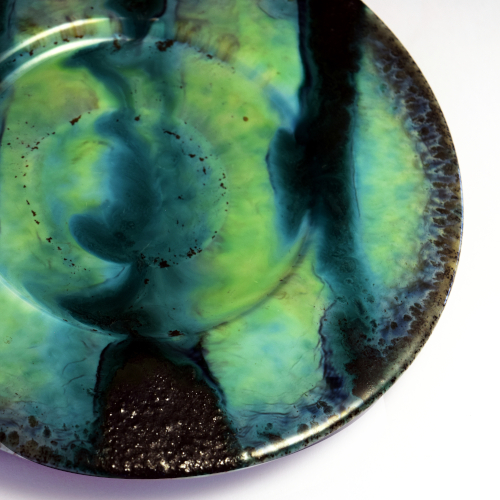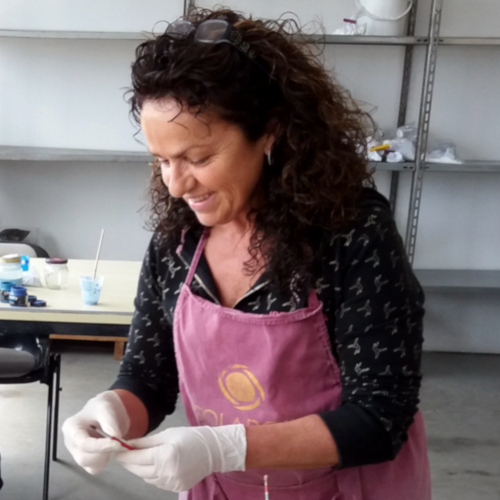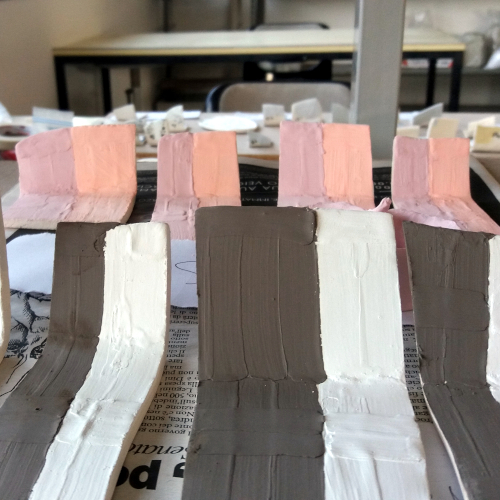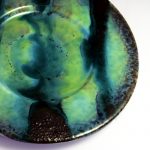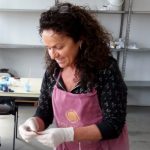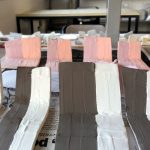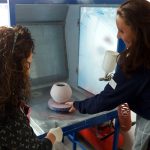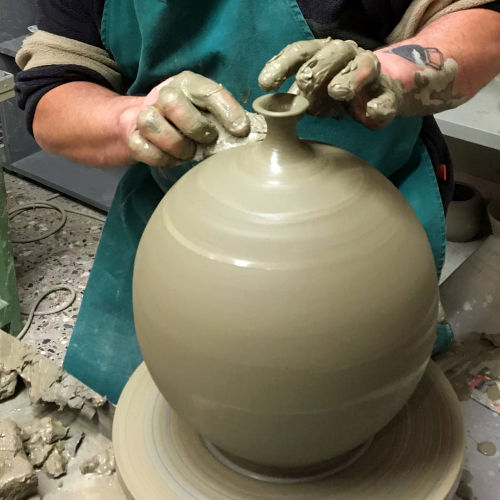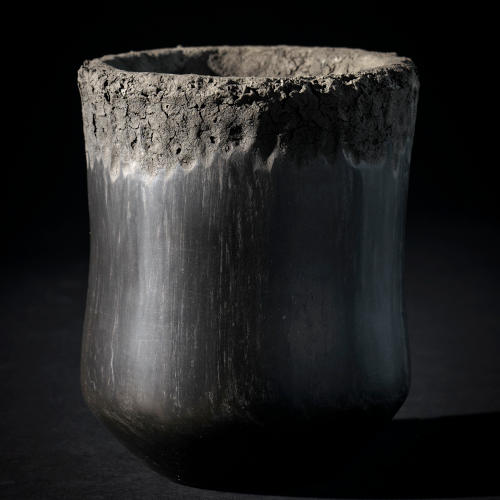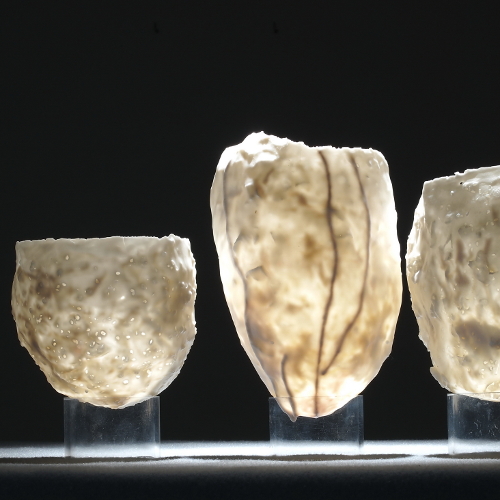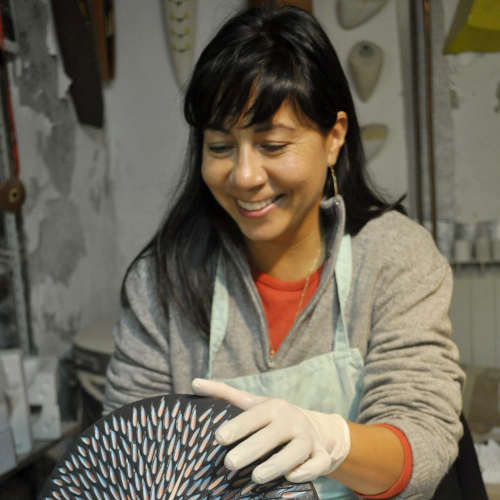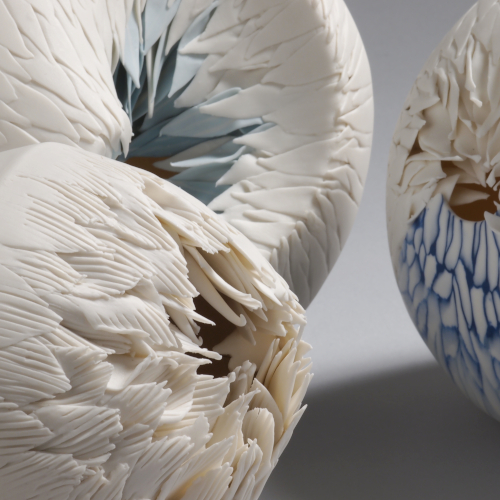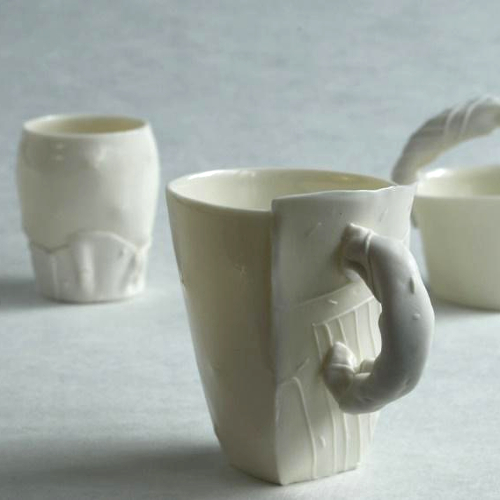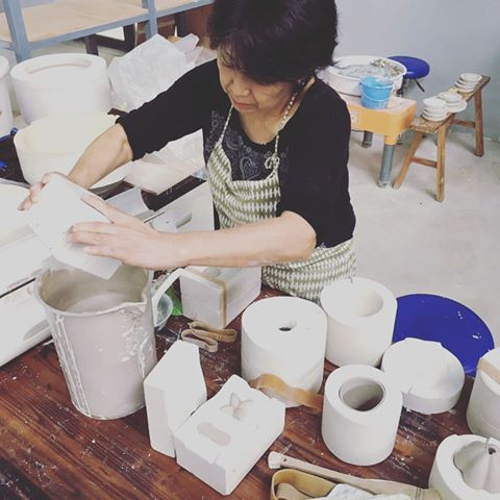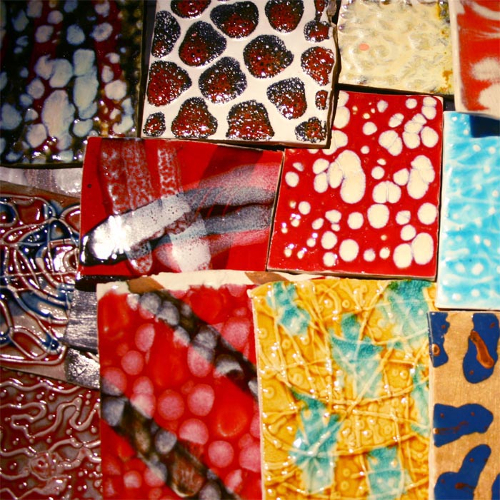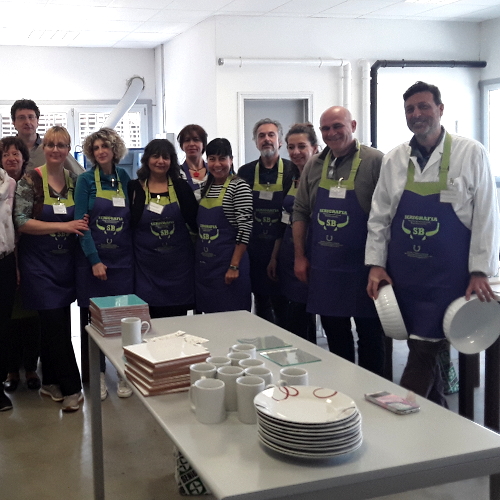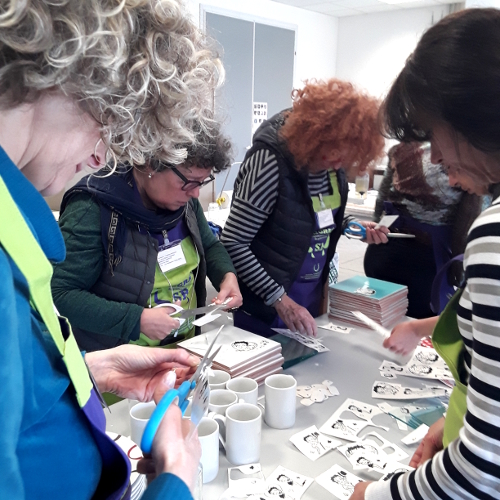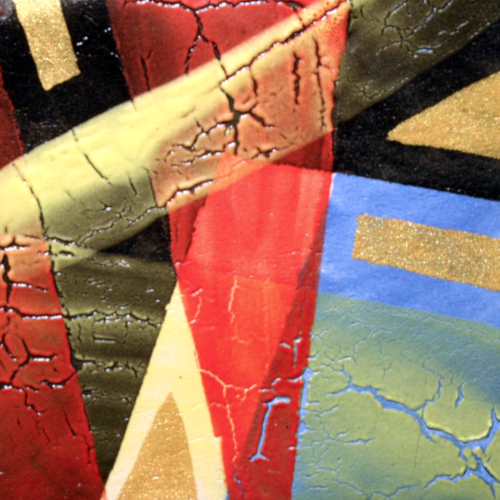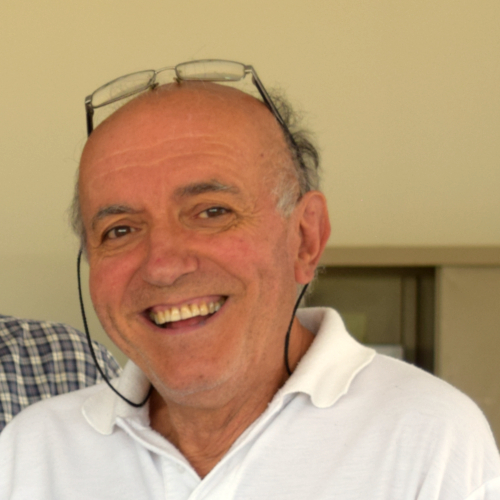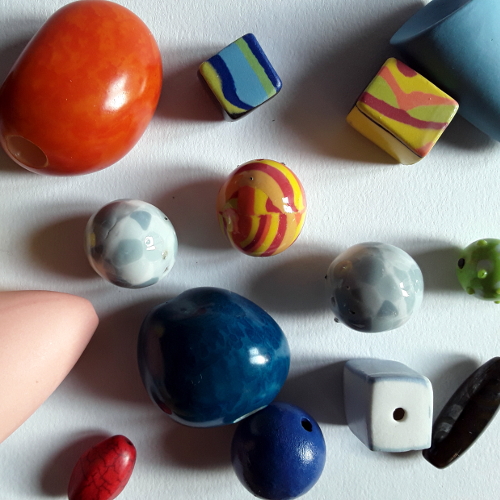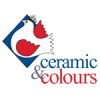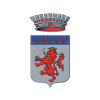CERAMIC MAZE: THE GLAZES | Vilma Bosi
16-17 March 2024
Learn how to work with glazes, easy application, decoration and firing of ceramics.
How much water should be added when preparing the glaze? How should you proceed to make a good application? In this course we want to introduce you to glazing ceramic artefacts by providing some basic specific skills. We will start with the knowledge of the products (Glazes, Transparent glazes, Colours, etc.) and their peculiarities, we will begin with how to proceed in their preparation and we will end with the opportunity to try out the main glazing techniques and a guide to ceramic firing. In particular, we will deal with application by immersion, spraying with an airbrush and brush glazing with the aid of special vehicles that allow for better application. We will present the necessary steps to obtain effects in the coatings also with applications in several layers that will be made on clay supports, already fired, provided by the organisation.
Vilma Bosi
In 1978 she began his work as a ceramist in Antonietta Mazzotti’s workshop where he became passionate and specialised in the decoration of ceramic artefacts. During her career, she collaborated with the Diva ceramics industry where she was in charge of the hand-decorated department and laboratory. Over time, her specialisation became the third fire (mainly gold and precious) thanks to which she collaborated with various artists and craftsmen in Italy. Among the most important are: La bottega Gatti, Fos Ceramiche, Padovani Ceramiche, Laboratorio Pesaro, Coralla Maiuri and Ceramic & Colours. In 2011, she was hired by Ceramic & Colours as laboratory manager, a role she still holds today. Since 2018 she has been teaching at the Faenza Art Ceramic Center.
The 14-hour course starts at 9 a.m. and ends at 5 p.m. on Saturday and starts at 9 a.m. and ends at 4-5 p.m. on Sunday.
Included in the course:
14 hours of teaching | the materials needed for the course | the firings | 2 brunch meals (breakfast and lunch) | a gift box (with samples of the materials used during the course)
Teacher: Vilma Bosi
Language: Italian
Download the full program in pdf
To confirm your inscription you have to make a bank transfer of a deposit or the total amount.
Related products
IMMEDIATE TRANSPARENCIES | Martha Pachon
11-12 May 2019
Transparency is one of the most important qualities of porcelain and usually requires a prolonged, precise and very accurate processing to obtain a piece of fine beauty highlighted by the translucency of the light. This course allows you to develop two simple and immediate techniques that will facilitate and strengthen creativity to develop many projects without the use of large resources and experience in the field of porcelain.
We will use the slip porcelain without the use of molds and single-firing and the two techniques, one for objects with organic shapes and another for objects with geometric shapes and more precise.
The 14-hour workshop lasts from 9.00 to 17.00 on Saturday and from 9.00 to 16.00 on Sunday.
Included in the Workshop cost: 14 hours of teaching | all the necessary materials | firings | nr. 2 brunch lunch | a box with the samples of the materials used during the workshopTeacher: Martha Pachon Languages: English, Italian, French, Spanish
Download the full program in pdf
To confirm your inscription you have to make a bank transfer of a deposit or the total amount.
DYNAMIC PORCELAIN | Martha Pachon
22-23-24 February 2019
Inspired by the new developments of contemporary ceramics, both utilitarian and decorative, sculptural or any application that can be made of this precious material, this course is structured as a laboratory of "multiprocesses" to know and master the basic techniques of slip and body porcelain. Understanding porcelain in a practical, direct, easy and fast way will be the goal of this course. Participants will have at their disposal different techniques, some simple and other complex, with and without the use of molds, with the possibility of glazing also in single firing, with theoretical chapter dedicated in detail to all the questions regarding porcelain: drying, breakage, deformation, firing curves, etc.
THE PARTICIPANTS, BEYOND TO BRING HIS FINISHED WORKS TO HOME, WILL HAVE THE RIGHT KNOWLEDGE OF ALL THE RESOURCES IN THE FIELD OF THE PORCELAIN: ITS QUALITY OF TRANSPARENCY, RESISTANCE, REFINEMENT AND WITHOUT GOING CRAZY!The 20-hour workshop lasts from 9.00 to 17.00 on Friday and Saturday and from 9.00 to 16.00 on Sunday.
Included in the Workshop cost: 20 hours of teaching | all the necessary materials | firings | nr. 3 brunch lunch | a box with the samples of the materials used during the workshopTeacher: Martha Pachon Languages: English, Italian, French, Spanish
Download the full program in pdf
To confirm your inscription you have to make a bank transfer of a deposit or the total amount.
The sophistication of japanese slip porcelain with Kazuko Uga
12, 13 e 14 Ottobre 2018
Ceramic maze: the glazes
17 and 18 February 2018
Il corso si prefigge di informare sui modi e le tecniche che sono alla base del processo ceramico per quanto riguarda la smaltatura e la decorazione a bassa temperatura.
Durante il corso saranno finite esperienze sui vari metodi di smaltatura ponendo particolare attenzione alla smaltatura a pennello con l’ausilio di particolari veicoli che ne consentono la migliore applicazione. Verranno presentate le cause alla base dei principali effetti ottenibili con i rivestimenti che saranno realizzate su supporti in argilla, già cotti, forniti dall’organizzazione: terracotta, terraglia tenera, terracotta di argilla da gres e semirefrattaria da Raku.
Sarà dato spazio anche al rapporto fondamentale degli smalti con i supporti e la loro preventiva miglior cottura a biscotto. Ed infine saranno affrontati anche i difetti che si riscontrano nella smaltatura e a questo proposito è possibile portare eventuali lavori personali finiti sulle cui problematiche sarà possibile svolgere una interessante lezione.
PROGRAMMA: esercizi personali di smaltatura: a pennello, ad aspersione, ad immersione – esercizi di decorazione con i colori sottovernice e i colori soprasmalto – smalti a rilievo – dimostrazione di smaltatura a spruzzo e a secco – Cottura delle prove – a domanda lezioni sulla chimica e tecnologia degli smalti.
Le forme saranno realizzate seguendo le indicazioni del docente, saranno cotte e consegnate entro i tempi del corso stesso. Il corso di 14 ore inizia alle ore 9.00 del sabato e termina alle ore 16.00 della domenica. Docente: Maestro Giovanni Cimatti Scarica il modulo di iscrizione in formato pdf Scarica il volantino in formato pdfSilk-screen printing Workshop
12, 13 and 14 May 2017
Questo corso ha lo scopo di fornire le conoscenze necessarie per creare le proprie decalcomanie vetrificabili e stamparle su diversi supporti ceramici o vetrosi. Inoltre attraverso la stampa grafica su ceramica, il corsista sarà introdotto a un campo poco esplorato, il vincolo dell’immagine ceramica con la lettura virtuale incorporando i codici QR. Questi codici offrono l’opportunità di reindirizzare la ceramica sul concetto di un progetto web (un blog, una pagina, una libreria virtuale, un videogioco, ecc.)Il corsista sarà introdotto nella pratica della elaborazione di una matrice, l’incisione in seta, la pulizia e il recupero dei telai, l’applicazione delle decalcomanie, l’uso di diversi supporti, la preparazione degli smalti e delle cotture. Sarà inoltre in grado di installare il proprio laboratorio di serigrafia con i più bassi costi possibili di attrezzature e risparmio dello spazio.
BIOGRAFIA SILVIA BARRIOSArtista e ricercatrice nata in Argentina. Si è specializzata nel campo dei nuovi media e delle tecnologie interattive applicate sulle arti del fuoco.Il suo tema di interesse attuale la “Ceramica Intelligente” deriva degli incontri fra la Serigrafia Ceramica e i processi creativi dei multimedia incentrati sulla bio-arte, l’elettronica, l’intelligenza artificiale e le arti digitali unitamente alle culture popolari sudamericane.Silvia Barrios è stata invitata con i suoi laboratori e istallazioni alla Biennale della Havana, la Biennale di SaoPaulo, e la Biennale di Mercosur, Buenos Aires. Ha realizzato diversi progetti internazionali, e ha esposto indiversi nazioni, fra loro, Cina, Italia, Spagna, Portogallo, Cuba, Argentina, Colombia, Ecuador e Perù.
Programma: Lezioni pratiche e teoriche finalizzate allo sviluppo della impressione di una immagine fotografica su un sopporto ceramico terroso o vitreo, crudo, biscottato o smaltato e anche sul vetro. Elaborazione della matrice, trattamento della seta per l’incisione. Pulizia e recupero dei telai. Applicazione delle decalcomanie. Uso dei diversi supporti: terracotta, terraglia, gres, porcellana, vetro. Preparazione degli smalti per serigrafia. Cotture a diversi ambienti. Come istallare il proprio laboratorio di serigrafia. Introduzione del codice QR alla serigrafia. Conferenza audiovisiva – Riassunto del processo per consolidare le conoscenze – Test e valutazione dei risultati Riflessioni sulla introduzione dei codici multi mediatici e la progettazione sul campo della ceramica contemporanea – Panorama dei progetti innovatori della ceramica nel campo della elettronica, intelligenza artificiale, bioscienza e robotica. Conclusioni con una mostra di un progetto artistico di gruppo dei corsisti.
Le forme saranno realizzate seguendo le indicazioni del docente, saranno cotte e consegnate entro i tempi del corso stesso. Il corso di 20 ore dura dalle ore 9.00 alle ore 17:00 del venerdì, dalle 9.00 alle ore 17:00 del sabato e dalle ore 9:00 alle ore 16.00 della domenica. Docente: Silvia BarriosLA SINTERRACOTTA | Giovanni Cimatti
30-31 March 2019
Una buona ceramica si distingue non solo per come è rivestita e la sua intrinseca arte ma sopratutto per il suo corpo che è forte e compatto quando è realizzata in gres. Oggi è possibile utilizzare un innovativo gres bianco, anche senza raggiungere la faticosa e costosa alta temperatura, ed avere la sinterizzazione di questa argilla in tutti i tipi di forni per ceramica.
Durante il corso faremo anche esperienza di come sia possibile ridurre ulteriormente i costi facendo una cottura unica di argilla e smalti che viene infatti definita monocottura. Useremo un'argilla plastica che rende facile modellare qualsiasi tipo di forma e particolari medium per l'applicazione a pennello di rivestimenti che saranno campiti anche con l'impiego di maschere adesive. Sara possibile infine anche applicare, in seconda cottura a 900 gradi, un simpatico e innovativo smalto oro.
Il corso di 14 ore inizia alle ore 9.00 e termina alle ore 17:00 del sabato e inizia alle ore 9:00 e termina alle ore 16.00 della domenica.
Compreso nel corso:14 ore di docenza | i materiali necessari allo svolgimento del corso | le cotture | nr. 2 pasti brunch (colazione e pranzo) | una scatola omaggio (con campionatura dei materiali utilizzati durante il corso)
Docente: Giovanni Cimatti Scarica il programma in formato pdfTo confirm your inscription you have to make a bank transfer of a deposit or the total amount.
Prehistoric firings
18 and 19 November 2017
Per chi ama i modi naturali e vede nella ceramica le varietà espressive che questi possono dare. Porterete tre forme essiccate (non cotte) di misura massima singola cm 20 (altezza) x 10 x 10 a spessore max mm7 realizzate in argille bianche da Raku. Le superfici delle forme potranno essere levigate a pressione ma non ingobbiate. Faremo esperienza di applicazione di argille su argille, di smalti in monocottura e di fiammature con cottura a legna che con la sua casualità ci mostrerà giochi infiniti di trasparenze, neri e lustri.
Programma: applicazione sulle vostre forme secche di ingobbi del genere Terra Sigillata, sali metallici, vernici e smalti – cottura notturna a biscotto – allestimento del fuoco e inserimento delle forme – cottura a legna – estrazione delle forme a mezza e fine cottura – lezioni di tecnologia a domanda.
Le forme saranno realizzate seguendo le indicazioni del docente, saranno cotte e consegnate entro i tempi del corso stesso. Il corso di 14 ore inizia alle ore 9.00 del sabato e termina alle ore 16.00 della domenica. Docente: Maestro Giovanni CimattiThe Pearl, from the beginning to the end
22, 23 and 24 june 2018
A complex and complete course to make the artist independent of creating large and small series of pearls for jewelery in various shapes, sizes and decorations. Making of molds, testing of slip and body porcelain, firing and decoration.
The italian mold expert Florio Bedeschi will be in charge of the first part of the course for the execution of small molds for pearls of different shapes and sizes.
A second part related to the use of the mold with slip and body porcelain, to the firing and decoration, will be with Martha Pachón Rodríguez.
PROGRAM:
- Fully practical lessons with both teachers. - Preparation of the necessary materials for the construction of the mold. - Preparation of the plaster and its use in the making of the mold, preservation of the mold. - Use of slip and body porcelain with the plaster molds. - Methods of pearl decoration. - How to apply on molds, dry and fire avoiding deformations. - The pieces will be finished, decorated and fired.
Teachers: Martha Pachon and Florio Bedeschi Languages: English, Italian, French, Spanish
Download the application form in pdf Download the program in pdf

